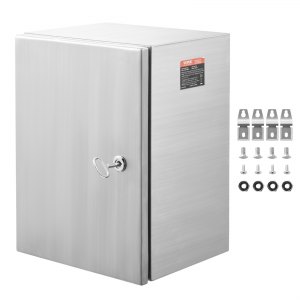Thanks for the input - I went ahead and ordered a 24x20x8, the Saginaw SCE-24EL2008LPLG with the galvanized subpanel SCE-24P20GALV from Automation Direct. An 8" enclosure will line up with the lathe and look better than the 10" would have. A 30" enclosure would have been silly once I laid out the components. After it was delivered yesterday, I was sweating a bit looking at it and the VFD depth once the subpanel was mounted, but there was plenty of room. I saw the Vevor enclosure but at the time had it in my head that I needed the 10" deep enclosure, and when I decided to go with the 8" forgot about it. The Saginaw enclosure and subpanel feel solid and should be easy to mount to; hard to tell if it is $200 better though.
There are so many great threads about these conversions, most I have read a dozen times over the last few months.
@mksj and
@B2 (among others) deserve a special thanks for their many posts. I purchased a lathe and knee mill at the same time and am converting both, starting with the lathe. I like the simplicity of the solid state design - I read the thread, but had missed the attachment with the full right-up. I previously worked in broadcast engineering, and most (analog) equipment came with schematics and a "Theory of Operation" section that described how the device worked, and the write-up reminded me of those and how useful they were.
I would be very interested in a PCB, though I ordered the 4PDT relay which I think is all that is required for the VFD source design. The solid state design will be easier to upgrade in the future, though why an upgrade would be needed is unknown... I like the idea of using the DRO scales to trigger the lathe to stop, replacing or augmenting the proximity sensor. From my research, the PM scales use RS422 to interface with the DRO, and RS422 can be read by multiple devices simultaneously by tapping the Rx pair. It seems fairly simple to add a Arduino or Raspberry Pi, reading the scale, creating a pseudo-proximity sensor trigger. Without having used the proximity sensor, the scales seem like they would be more deterministic and repeatable, and eliminates the cables in the front.
The micrometer carriage stop has been backordered for a while, so the proximity sensor is missing a key component. I may have a go at the DRO scales as the trigger once I get the conversions completed. I ordered the DRO installed, primarily for the install, and intended to replace the head unit with a TouchDRO instance, at least on the mill. I've done a several applications with the Pi and linear/rotary encoders, and if a scale is similarly encoded a lot of the domain knowledge would transfer. (The rotary encoder state machine can be run via dtoverlay, eliminating missed steps, while the application runs in user space and can be preempted. My concern is slight delays periodically, but those delays would be milliseconds unless the operator did system updates while threading, a practice I would discourage.)
Thanks for the help - I'm sure I'll have more questions to come.

